What's Going On In Your Horse's Mouth?
My Quarter Horse filly, Stella, will be two years old this spring. I was planning to start her under saddle after a few weeks of ground work. Since I wanted to bit her up and drive her before riding, I knew that she would need her teeth checked first. By simply running my hand along her tooth edges and peering into her mouth, I had already discovered that she had sharp edges and wolf teeth that needed to be removed before I put a bit in her mouth the first time. Hereford needed his done also, so I made them an appointment with Dr. Roger Cole in Marshfield. On the morning of their appointment I loaded Stella and Herf and away to Marshfield we went.
For those of you who don't know Dr. Roger Cole, let me just say he's a great guy. He's one of those people who truly loves horses and it shows in his care and handling of them. He loves horses, and horses love him. One of the many reasons I recommend him to clients is that he will take his time and explain everything as he goes. Whether speaking to one person or a dozen, he will happily explain what he is doing and why, and will take plenty of time to let you get a good look inside your horse's mouth. A trip to Dr. Cole's is always fun and educational.
Here are the before and after pictures of Stella, along with some photos I snapped of a few horse skulls Dr. Cole keeps on hand for client education. It's nearly impossible to get a good look in a horse's mouth that isn't sedated, but by looking at a skull you can easily see the layout of the teeth and how they can affect your horse's comfort and health.
The Horse's Mouth

This is the skull of a six year old horse. Horses chew by moving their jaws side-to-side, grinding up their food. In this picture, I have labeled the teeth and TMJ joint. This skull has several problems that often affect horses.
The TMJ (Temporomandibular Joint) is very important because it is the joint that allows the horse's huge bottom jaw to move. If this joint is compromised, it affects the horse's ability to eat. Horses naturally eat small amounts of grass from the ground for many hours a day. Forcing horses to live in stalls, eat from raised mangers or hay racks, and feeding lots of soft hay and concentrated grain all lead to problems with the teeth and the TMJ. By eating off of the ground, the horse is able to naturally release the jaw downward and relax it; and by eating lots of rough grass, he is better able to wear down his teeth evenly by chewing in long strokes from side to side. Horses not allowed to eat from ground level, and not allowed adequate grazing or time to nibble hay at liberty may develop issues with uneven wear and joint misalignment. The more problems the horse develops with his teeth, the more he will have to alter his chewing patterns to try to compensate, which will only cause his teeth to become even more uneven. You can see how this soon progresses into an endless vicious cycle which causes horses to be unable to digest properly and become "hard keepers", unable to gain or keep a healthy weight.
With the addition of a bit, the problems really get worse. The bit shoves the tongue into the sharp edges of the teeth, lacerating it. If the horse has wolf teeth, the bit will likely slam into them causing sharp pain. (Ever hit your teeth with a fork?) Horses with mouth pain will usually fight the bit, throw their head around, panic and just generally be difficult about bridling and riding. Many times I get horses in for training that have behavior problems stemming from a lack of good dental care by a competent veterinarian. I won't even start working with them until we get their mouth in order. After a visit with the vet, they get a few days to recover. Then we can proceed with overcoming their fear and pain-based bad habits. For some horses, it may be the first time in years that their sensitive mouths have not been subjected to intense discomfort when bridled. Many horses are just forced into harsher bits and tie-downs by their owners who just think "he likes to throw his head". How ridiculous is that? He doesn't "like" to throw his head; he throws his head because that's the only way he can tell you he is in pain. Unfortunately for him, if you don't know that's what he is saying, you are likely to react by causing him even more pain. The poor horse is pretty much stuck in a situation where he can't win. The more he fights, the more he'll get hurt. If he gives up and takes it, he'll still be hurt. There's little in this world that is more miserable than being at the mercy of someone who doesn't know better.
A Closer Look At Some Common Problems

In the picture above, you can see there is a tooth labeled "wolf tooth". This is the first premolar tooth. Not all horses will have wolf teeth. Some may have from one to four. Many horses only have them on top, and some horses may have wolf teeth that never erupt, but occasionally cause soreness and inflammation. Generally, when a colt is castrated, the vet will check to see if it has wolf teeth. Make a point to ask your vet to check for them. Fillies can also have them so you'll need to periodically check them as well. In the above photo, the wolf tooth, or first premolar, sticks out right where a bit would be forced into it even if the rider was careful.
The periodontal pockets are basically holes in the gums. Small pieces of food get caught in these holes and as they decay cause them to grow larger and larger. With long term infection, more and more bone is lost and eventually teeth in affected areas will fall out. Lost teeth will cause the tooth on the opposing jaw to grow up/down into the empty space since it no longer has contact with a grinding surface, effectively binding up the jaw and preventing chewing.
The sharp enamel points catch the cheek flesh and tear and irritate it, causing ulcers (canker sores). Most of us have bitten the inside of our cheek before and are aware how painful that can be. Remember how when you bite your cheek, the tissue swells and causes you to keep biting it every time you chew? That is VERY painful. In horses, the ulcers can eventually grow to run the length of the horse's cheek and over time get so deep that they eat through nearly to the outside.
The high ridges above the sharp points are called accentuated transverse ridges. This simply means that ridges have formed because the top teeth don't line up properly with the bottom teeth, allowing the ridges to form as the teeth grow out and wear down unevenly. If they line up, each tooth grinds down the opposite one and prevents the ridges from forming. The more the horse chews the longer and sharper these points will become. The sharper they become, the more the horse will tear up his cheeks while eating. While riding, every time the reins are pulled even a little, it will force the tongue into these sharp edges.
All young horses should have their teeth done by a vet before they are started into bridle training. Those first few sessions are very important in setting up your horse to be a willing partner for the rest of his life. If you allow him to be hurt you are setting him up to be anxious, mistrusting, and afraid of being ridden or trained. That's NOT a good start to what should be a positive and trusting working relationship between the two of you. The majority of all horses have tooth issues that affect their ability to be ridden comfortably.
Dr. Cole And Stella
Following are pictures of Stella's trip to the dentist along with explanations of her issues.
(Caution note for the squeamish: Contains pictures of dental procedures.)
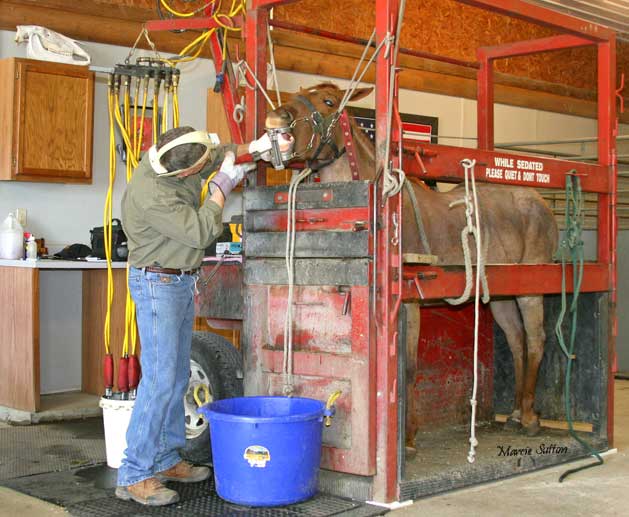
Here Stella is sedated (notice the relaxed back leg and droopy muscles) and she is securely enclosed in the stocks. Dr. Cole has put a speculum in her mouth to hold her jaws open during the procedure. In this picture he is grinding the sharp edges of her teeth down. Her head is supported by a harness because she is very sleepy and only vaguely aware of what he is doing.
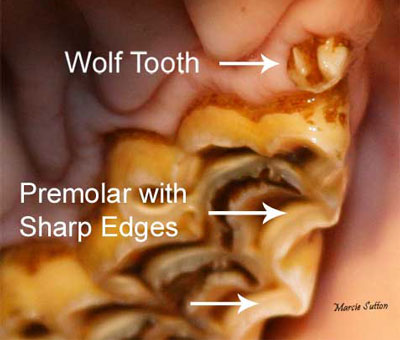
1) Here you can see Stella has long, sharp edges and a wolf tooth on her upper left side. The right side looked the same. She was a few weeks from her second birthday at this time. It's a good thing I didn't start her training with a bit before this. |

2) In this picture Dr. Cole is cutting the gum around the tooth on the right side to facilitate removal. This step only takes a few seconds but will make the procedure much easier. |

3) Prying the tooth up to elevate it so there is more area available to grip. |
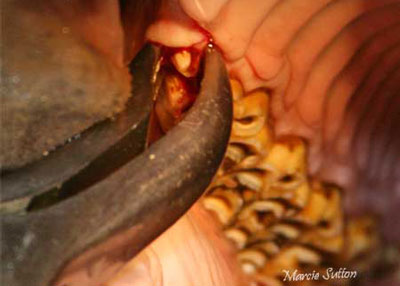
4) Now he can easily grip the tooth and work it out. |
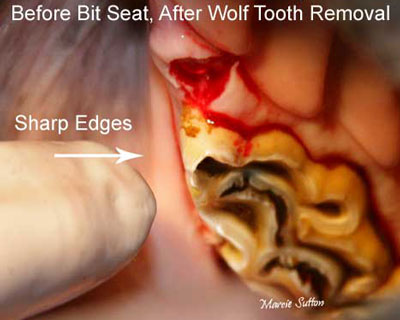
5) Here you can see that the wolf tooth is out, but there are still sharp edges that need to be ground down. Since a bit will sit next to that tooth, and will be pulled toward it, Dr. Cole will put in a "Bit Seat" to help prevent discomfort (see explanation below). |

6) All finished. The wolf tooth is gone, the sharp edges, ridges and points have been ground smooth, and the front premolar has been shaped to help prevent discomfort when a bit is used. She will now be able to chew more efficiently with less pain, which means she can digest better and save me some money on the feed bill. I won't have to over-feed her to keep her weight on. A definite win for both of us! |

Stella is still very sleepy here, but will be allowed to wake up and get steady on her feet before we load up and go home. Once home she'll nap for several hours and be awake and alert in time for supper. She'll have a few days to recover and then she will be ready to begin training.
Over the next year, Stella will start getting permanent teeth. As the premolars and molars come in at roughly 2 1/2 years of age, 3 - 3 1/2 years of age, and 4 - 4 1/2 years of age, they will slowly push the deciduous, or baby, teeth out. Often these baby teeth "cap" the new tooth and get stuck. A cap may cause trouble if it does not fall free.
Bit Seat
Often folks hear their veterinarian or trainer mention a "Bit Seat", but may not be sure what it means. Here is a good look at a horse skull that has had a bit seat put in one side, while the other side was left natural for comparison. The nearest side shows how the second premolars (a wolf tooth, if present, is actually the first premolar) have been rounded to make more room for the bit. There are no sharp edges left for the bit to bump into, and if the horse's tongue is pressed into the teeth here it won't be injured. Many horses show marked improvement in bit response once they have a bit seat.

Left side of horse skull showing bit seat on premolars. Right side is unaltered.
Mature Horses
Now that you've seen what may be happening in your youngster's mouth, let's take a look at what is going on in some more mature horses. The following are pictures I have taken from over Dr. Cole's shoulder in past years. The horses belong to my clients and I can honestly say each of them received the best in care in every other way possible. These owners had no idea their horses needed dental work. Some of these horses in particular were on the best possible regimens of deworming, high quality hay and feed, and some of the best supplements available, along with routine hoof care and vaccinations.
The only thing missing was dental care.
Many farriers "do teeth" and are relied upon by the average horse owner to tell them when there is a problem. Unfortunately, it's just not that easy to see into a horse's mouth without sedation, a speculum and a bright light. A farrier is not legally allowed to sedate someone else's horse, so when he or she does teeth, he is usually forced to blindly shove a sharp rasp in and do the best he can. Some are fairly good at it, all things considered, but most often they simply cannot see what they are doing. Regardless of the good intentions behind it, blindly rasping at bad teeth can sometimes do more harm than good.
I have personally seen horses' teeth that were pronounced "fine" by a farrier (or even a vet who just glanced in their mouth!) that were in terrible dental shape. I have also watched these horses get their teeth done properly and seen that they were anything but "fine". Here's a few of the photos I have taken during these sessions:
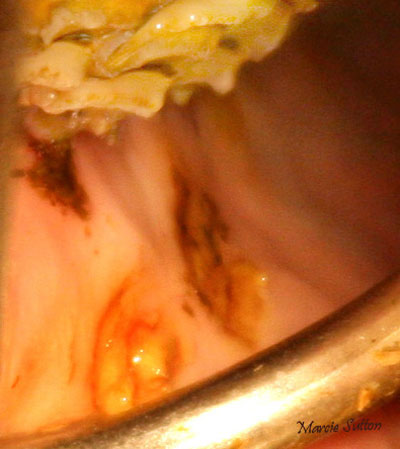 |
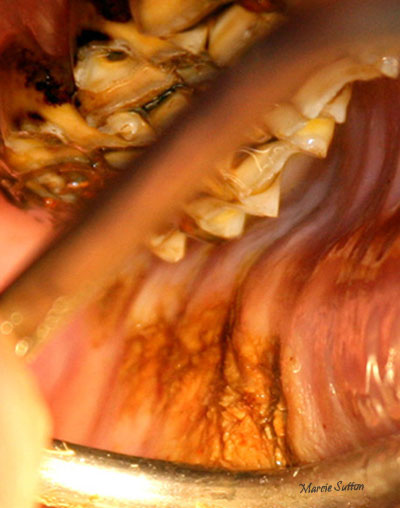 |
| These two photos above are from horses who received the best in care in every way possible, but their owners had no idea that the information they had been given over the years regarding mouth health was incorrect. They thought they were taking excellent care of their horses. | |
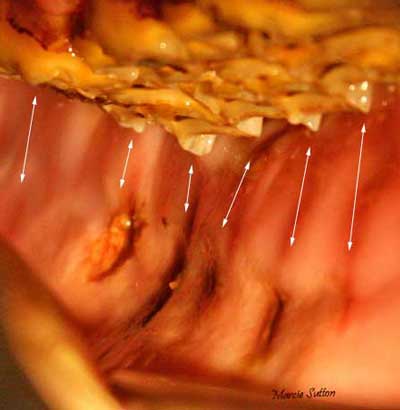 |
The owner of this particular horse (picture at left) was horrified when Dr. Cole showed her this mess. Notice the damaged areas in the cheek of this horse and how little of the tissue is healthy and light pink. Note the irritated grooves that lead from each sharp point down to the laceration the point has caused. After this horse was treated, he quickly started gaining weight, got a healthy, shiny coat and required much less feed and supplementation to keep weight on. His whole demeanor and personality changed for the better and today he is happy and healthy. To me, one of the interesting things about this picture is that you can see the damage as it is progressing. See how in the second through fourth lacerations, the point above is larger and older? If you look at the one on each end, they are newer points and have only just started to cut into the cheek. You can imagine how bad the damage would have been in another year. Remember, with each grinding stroke of the horse's jaws as he chews, those teeth get sharper and sharper, just like when we sharpen a knife or tool. |
You can easily see that no matter how good the rest of the care your horse receives, unless they are getting proper dental care they may be having a hard time not only chewing their dinner, but also in a lot of pain when you bridle them. It's little wonder that so many run when they see us coming at them with a bridle. At the very least, most horses need their teeth done every other year. For working horses or regularly ridden pleasure horses, at least once a year is recommended.
I know that doing right by our horses can be expensive. I also know that we need to figure in the cost of care for these animals and whether we can manage to provide it, BEFORE we acquire them. Remember, buying the horse is usually the cheapest part. It's the care and upkeep that costs the most. If you get a horse, throw it in the pasture and ignore it except for when you want to use it, then you are not going to have a happy, healthy horse, or a great relationship with it. Sure, some horses with gentle souls may tolerate you, but that only goes to show just how forgiving and wonderful these creatures truly are. Such dedication deserves to be rewarded with kind and humane treatment. I believe we owe them that much.
I'd like to thank Dr. Roger Cole for allowing me to photograph his work, and my training clients for allowing me to photograph their horses and use them to help teach others. Thanks guys, I appreciate it.
-- Marcie